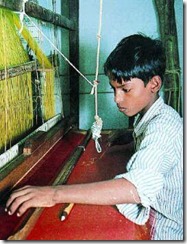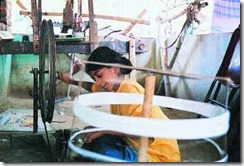One major difference between slavery in the past and contemporary slavery is the price of slaves. The price of human beings during the Trans-Atlantic slave trade was about 40,000 dollars on average. Due to population explosion, the average price of a human being today, around the world, is about 90 dollars.

Debt bondage is the use of slavery as a means of repaying debts. In India, harsh poverty drives parents to sell their children into debt bondage. At least 350,000 debt bonded children are working in the Indian silk industry. Mature cocoons are transformed into silk thread through a process of reeling and twisting. Children are cooking cocoons, picking out the dead worms, twisting the filaments into thread, and helping with odd jobs.
Three Indian children tell their slave narratives:
P. Kattaraman‘s parents sent him to work when he was around six years old in exchange for a Rs. 3,000 (U.S.$63) advance to pay for his sister’s marriage. He worked for five or six years at a silk twisting unit: “The conditions of working were very difficult… When we took too long or if the thread broke in the middle, we would get beaten… There was no rest for eating. We ate while working. We paid Rs. 2.50 [U.S.5¢] for a meal from the hotel. This was cut from our wages.”
Yeramma S., eleven years old: Before I came here I went to [a government] school, but after one year I withdrew from school because of a problem–my sister’s illness. After my sister got sick, we took her to the hospital, but the doctor said we had to pay more money, so my parents bonded me for Rs. 1,700 [U.S.$35]. I was seven or eight years old. I did winding [unwinding the cocoons]. I didn’t like to work, but I was forced to by my parents. They said I couldn’t go to school but had to work… At 4:00 a.m. I got up and did silk winding… I only went home once a week. I slept in the factory with two or three other children. We prepared our food there and slept in the space between the machines. The owner provided the rice and cut it from our wages–he would deduct the price. We cooked the rice ourselves. We worked twelve hours a day with one hour for rest. If I made a mistake–if I cut the thread–he would beat me. Sometimes [the owner] used vulgar language. Then he would give me more work.

Mayekalai J., ten years old: I worked in the silk unit. I worked with thread and then sometimes cleaning and sweeping. When I first started working, older children were there, and they taught me how to do the work. I started work when I was about seven years old. I got a Rs. 2,000 [U.S.$42] advance–it was less because I had no experience. I didn’t get any wages because I was young. Later my wages went straight to my parents, and I don’t know how much it was. Once a week I got Rs. 10 [U.S.21¢] from my parents for pocket money. I spent it on small balls, snacks–chickpeas and chocolate, sweets… I wanted to play with children, and sometimes I was unhappy. I would see the neighbors’ children going to school, and I would think, “What am I doing here?” Sometimes I thought about running away. Once I escaped from the silk unit and went home. The owner came to my house, and my parents convinced me not to leave again without their permission, so I went back with the owner.
Slave narratives are from: Bonded Labor in the Silk Industry, India
Images by S. Thanthoni, from Frontline: Behind the Bright Silk
[…] READ THIS POST IN ENGLISH […]